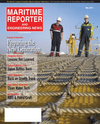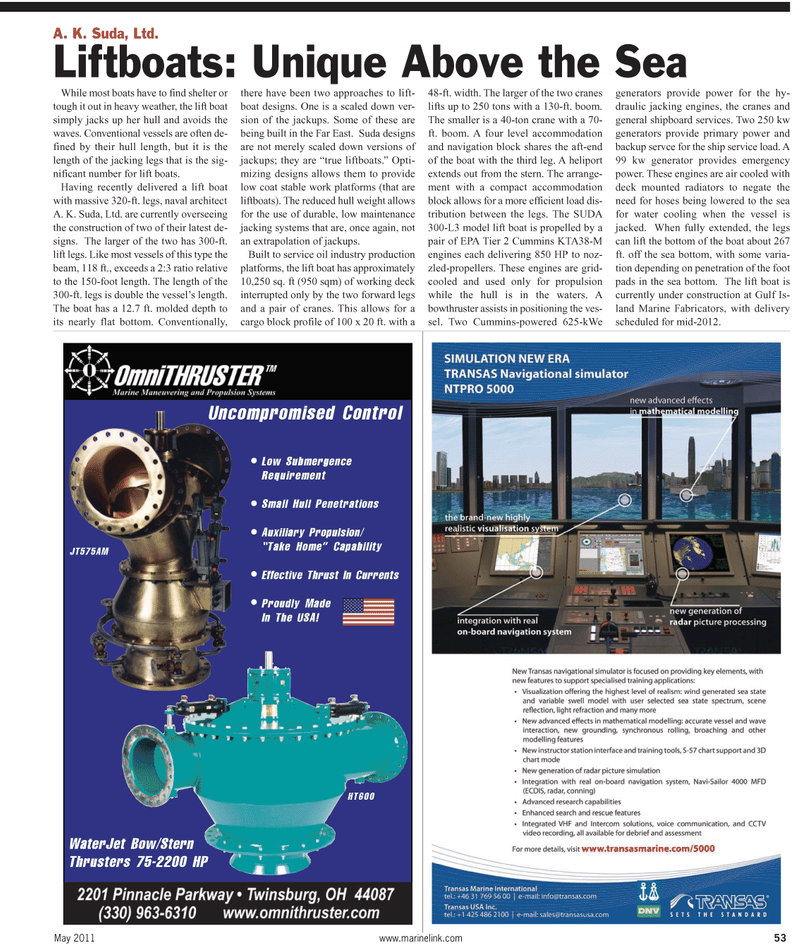
Page 4th Cover: of Maritime Reporter Magazine (May 2011)
Training & Education Edition
Read this page in Pdf, Flash or Html5 edition of May 2011 Maritime Reporter Magazine
May 2011 www.marinelink.com 53
While most boats have to find shelter or tough it out in heavy weather, the lift boat simply jacks up her hull and avoids the waves. Conventional vessels are often de- fined by their hull length, but it is the length of the jacking legs that is the sig- nificant number for lift boats.
Having recently delivered a lift boat with massive 320-ft. legs, naval architect
A. K. Suda, Ltd. are currently overseeing the construction of two of their latest de- signs. The larger of the two has 300-ft. lift legs. Like most vessels of this type the beam, 118 ft., exceeds a 2:3 ratio relative to the 150-foot length. The length of the 300-ft. legs is double the vessel’s length.
The boat has a 12.7 ft. molded depth to its nearly flat bottom. Conventionally, there have been two approaches to lift- boat designs. One is a scaled down ver- sion of the jackups. Some of these are being built in the Far East. Suda designs are not merely scaled down versions of jackups; they are “true liftboats.” Opti- mizing designs allows them to provide low coat stable work platforms (that are liftboats). The reduced hull weight allows for the use of durable, low maintenance jacking systems that are, once again, not an extrapolation of jackups.
Built to service oil industry production platforms, the lift boat has approximately 10,250 sq. ft (950 sqm) of working deck interrupted only by the two forward legs and a pair of cranes. This allows for a cargo block profile of 100 x 20 ft. with a 48-ft. width. The larger of the two cranes lifts up to 250 tons with a 130-ft. boom.
The smaller is a 40-ton crane with a 70- ft. boom. A four level accommodation and navigation block shares the aft-end of the boat with the third leg. A heliport extends out from the stern. The arrange- ment with a compact accommodation block allows for a more efficient load dis- tribution between the legs. The SUDA 300-L3 model lift boat is propelled by a pair of EPA Tier 2 Cummins KTA38-M engines each delivering 850 HP to noz- zled-propellers. These engines are grid- cooled and used only for propulsion while the hull is in the waters. A bowthruster assists in positioning the ves- sel. Two Cummins-powered 625-kWe generators provide power for the hy- draulic jacking engines, the cranes and general shipboard services. Two 250 kw generators provide primary power and backup servce for the ship service load. A 99 kw generator provides emergency power. These engines are air cooled with deck mounted radiators to negate the need for hoses being lowered to the sea for water cooling when the vessel is jacked. When fully extended, the legs can lift the bottom of the boat about 267 ft. off the sea bottom, with some varia- tion depending on penetration of the foot pads in the sea bottom. The lift boat is currently under construction at Gulf Is- land Marine Fabricators, with delivery scheduled for mid-2012.
Uncompromised Control
WaterJet Bow/Stern
Thrusters 75-2200 HP
JT575AM
HT600
Low Submergence
Requirement
Small Hull Penetrations
Auxiliary Propulsion/ “Take Home” Capability
Effective Thrust In Currents
Proudly Made
In The USA!
A. K. Suda, Ltd.
Liftboats: Unique Above the Sea

 3rd Cover
3rd Cover

